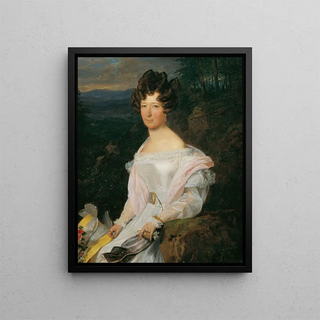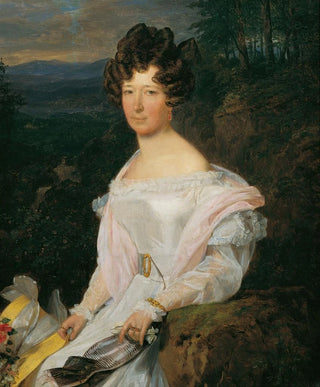Art print Dame in white dress in front of a Viennese forest landscape - Ferdinand Georg Waldmüller | Art print


View from behind

Frame (optional)
In a soft burst of light, the artwork "Dame en robe blanche devant un paysage des bois viennois" by Ferdinand Georg Waldmüller stands out as a true masterpiece of the 19th century. This painting not only evokes the beauty of a frozen moment but also the emotions and stories hidden behind each brushstroke. As viewers contemplate this scene, they are immediately transported into a universe where nature and humanity intertwine harmoniously, revealing the full depth of Waldmüller's art. The lady, dressed in a dazzling white dress, appears both elegant and mysterious, inviting the viewer to ponder her story and her connection to the surrounding landscape.
Style and uniqueness of the artwork
Waldmüller's work is distinguished by its striking realism and meticulous attention to detail. The way he captures the light and texture of natural elements is simply remarkable. In this painting, the lush green of the Viennese woods blends with the immaculate whiteness of the lady's dress, creating a visual contrast that draws the eye and sparks the imagination. Every blade of grass, every leaf, seems rendered with precision that reflects the artist's love for nature. The composition, both balanced and dynamic, invites the viewer to explore the painting, to lose themselves in the nuances of color and the subtleties of light. Waldmüller manages to breathe vibrant life into his subjects, transforming a simple scene into a true sensory experience.
The artist and his influence
Ferdinand Georg Waldmüller, an emblematic figure of Austrian Romanticism, left his mark on his era through his innovative approach to painting. Born in 1793, he was influenced by the great masters of the past while developing a style that was uniquely his own. Waldmüller not only explored themes of everyday life but also emphasized the importance of the individual within the natural setting. His work paved the way for many artists, contributing to a redefinition of landscape painting in the 19th century.

Matte finish

View from behind

Frame (optional)
In a soft burst of light, the artwork "Dame en robe blanche devant un paysage des bois viennois" by Ferdinand Georg Waldmüller stands out as a true masterpiece of the 19th century. This painting not only evokes the beauty of a frozen moment but also the emotions and stories hidden behind each brushstroke. As viewers contemplate this scene, they are immediately transported into a universe where nature and humanity intertwine harmoniously, revealing the full depth of Waldmüller's art. The lady, dressed in a dazzling white dress, appears both elegant and mysterious, inviting the viewer to ponder her story and her connection to the surrounding landscape.
Style and uniqueness of the artwork
Waldmüller's work is distinguished by its striking realism and meticulous attention to detail. The way he captures the light and texture of natural elements is simply remarkable. In this painting, the lush green of the Viennese woods blends with the immaculate whiteness of the lady's dress, creating a visual contrast that draws the eye and sparks the imagination. Every blade of grass, every leaf, seems rendered with precision that reflects the artist's love for nature. The composition, both balanced and dynamic, invites the viewer to explore the painting, to lose themselves in the nuances of color and the subtleties of light. Waldmüller manages to breathe vibrant life into his subjects, transforming a simple scene into a true sensory experience.
The artist and his influence
Ferdinand Georg Waldmüller, an emblematic figure of Austrian Romanticism, left his mark on his era through his innovative approach to painting. Born in 1793, he was influenced by the great masters of the past while developing a style that was uniquely his own. Waldmüller not only explored themes of everyday life but also emphasized the importance of the individual within the natural setting. His work paved the way for many artists, contributing to a redefinition of landscape painting in the 19th century.
12,34 €






